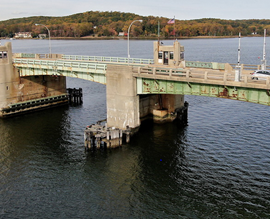The new federal infrastructure law includes “enormous investments, some of the largest we’ve ever seen in some areas,” according to Erich Zimmermann, Deputy Director and Transportation Director of the National Association of Regional Councils. Zimmermann spoke at the annual meeting of the
Metropolitan Area Planning (MAP) Forum on December 3.

Signed into law on November 15, the Infrastructure Investment and Jobs Act (IIJA) – also known as the Bipartisan Infrastructure Law (BIL) – totals $1.27 trillion, with $550 billion in new spending. Zimmermann said more than 42 sections of the new law impact the planning and capital programming work of metropolitan planning organizations (MPOs) and regional councils, including the members of the MAP Forum. The MAP forum is composed of representatives of 10 MPOs and regional organizations in New York, New Jersey and Pennsylvania, including the NJTPA.
Together with extensive formula and discretionary funding for highway, water, broadband and other infrastructure, the bill includes “the largest investment in rail ever seen,” totaling $100 billion over five years, Zimmermann said. The funding supporting the work of MPOs will increase 32 percent and MPOs must now take housing into consideration in drawing up long-range plans.
Other programs coordinated by MPOs and benefiting counties and municipalities also saw large increases, such a 71 percent increase in the Transportation Alternatives Program (TAP), which funds non-traditional transportation projects. Two new formula-funded programs target reducing transportation’s contribution to climate change and making infrastructure more resilient to climate impacts.
Zimmermann highlighted a few of the “very long list” of discretionary grant programs in the new law that address “a gamut of issues.” This includes the Congestion Relief Program to encourage innovations in addressing congestion such as congestion pricing; and Safe Streets and Roads for All, a grant program that supports Vision Zero safety strategies. A number of pilot programs will test approaches to funding transportation through mileage-based user fees, prioritizing proposed projects, removing obsolete infrastructure dividing neighborhoods, and accommodating wildlife crossings, among others. He said implementing all the programs will involve an “unbelievable amount of rule-making” by the U.S. Department of Transportation in coming months.
Despite the welcome new funding in the law, Zimmermann said the IIJA does nothing to solve the underfunding of the federal Highway Trust Fund, which relies mostly on gas tax revenues. Rather, he said, the law transfers $118 billion in funding from the general fund to the trust fund, continuing the practice of past transportation acts.
The NARC summary of the law can be found at:
https://narc.org/2021/10/01/infrastructure-investment-and-jobs-act-bill-analysis/
Click here to view Zimmerman's presentation.